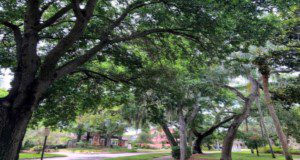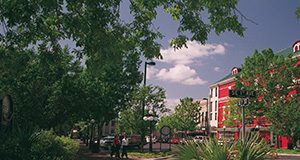This new 13-page article combines canopy coverage data from all of Florida’s metropolitan and micropolitan areas with ecological models developed by the USDA Forest Service to calculate several key benefits of urban trees and an approximation of their monetary value. Benefits of urban trees include carbon sequestration/storage, air pollution filtration, and stormwater mitigation. Written by Drew C. McLean, Andrew K. Koeser, Deborah R. Hilbert, Shawn Landry, Amr Abd-Elrahman, Katie Britt, Mary Lusk, Michael G. Andreu, and Robert J. Northrop, and published by the UF/IFAS Environmental Horticulture Department.
https://edis.ifas.ufl.edu/ep595
Tag: Robert J. Northrop
Urban Tree Selection for Diversity
Urban tree diversity is important when attempting to create a healthy, beneficial, and resilient urban forest. Having a variety of trees can increase the aesthetic value for residents and create habitats for plants and animals. Some common street trees currently in the landscape are not site-appropriate and create infrastructure damage. By planting different types of trees in these locations, maintenance costs and infrastructure damage can be reduced and tree longevity increased. This new 4-page fact sheet is intended to provide urban foresters, arborists, landscape designers, and others in charge of tree planting with a process for introducing new species into the urban environment. Written by Deborah R. Hilbert, Andrew K. Koeser, and Robert J. Northrop, and published by the UF/IFAS Environmental Horticulture Department.
https://edis.ifas.ufl.edu/ep589
Executive Summary of Gainesville’s Urban Forest in 2016
This 2-page fact sheet written by Michael G. Andreu, Caroline A. Hament, David A. Fox, and Robert J. Northrop and published by the UF/IFAS School of Forest Resources and Conservation describes a 2016 ecological assessment of the urban forest in the city of Gainesville, FL. It provides a detailed look into some of the economic and ecological values of the forest to enhance understanding and improve urban forest policies, planning, and management, as well as to provide empirical data for the inclusion of trees within environmental regulations.
http://edis.ifas.ufl.edu/fr417
Values and Ecosystem Services of Gainesville’s Urban Forest in 2016
The urban forest is a crucial factor in the well-being of a community because of the aesthetics, health benefits, and cost-savings that it provides. The urban forest is our habitat, and we must manage it in ways that will provide the benefits we need and desire. This 3-page fact sheet written by Michael G. Andreu, Caroline A. Hament, David A. Fox, and Robert J. Northrop and published by the UF/IFAS School of Forest Resources and Conservation describes an urban forest ecological analysis conducted in 2016 in Gainesville, Florida, by the University of Florida in partnership with the Parks, Recreation, and Cultural Affairs Department to quantify the vegetation structure, functions, and values of the urban forest.
http://edis.ifas.ufl.edu/fr414
The Structure and Composition of Gainesville’s Urban Forest in 2016
Trees in cities were formerly thought of merely as a collection of individuals found along streets and incorporated into landscaping. However, urban trees are now viewed as being part of a unique forest type, and understanding the urban forest’s structure and composition is an important first step towards managing it. This 4-page fact sheet written by Michael G. Andreu, Caroline A. Hament, David A. Fox, and Robert J. Northrop and published by the UF/IFAS School of Forest Resources and Conservation aims to provide a broader understanding of the urban forest in the city of Gainesville, Florida.
http://edis.ifas.ufl.edu/fr413
FOR209/FR271 The Structure and Composition of Tampa’s Urban Forest
FOR-209, a 4-page illustrated fact sheet by Michael G. Andreu, Melissa H. Friedman, and Robert J. Northrop, presents the information gained about the distribution of vegetation and variety of species in Tampa’s urban forest from an urban ecological assessment conducted in the city of Tampa. Includes references. Published by the UF School of Forest Resources and Conservation, February 2009.
http://edis.ifas.ufl.edu/FR271
FOR204/FR266 Environmental Services Provided by Tampa’s Urban Forest
FOR-204, a 5-page illustrated fact sheet by Michael G. Andreu, Melissa H. Friedman, and Rob J. Northrop, provides a brief overview and results from an urban ecological assessment conducted in the city of Tampa from February to July 2007. Includes references. Published by the UF School of Forest Resources and Conservation, January 2009.
http://edis.ifas.ufl.edu/FR266
FOR194/FR255 Community Leaders’ Perceptions on Urban Forests in Hillsborough County, Florida
FOR-194, a 2-page fact sheet by Francisco Escobedo, Jennifer A. Seitz, Rob J. Northrop, Molly K. Moon, compares the results from a needs assessment in Hillsborough County to a national urban tree survey and shares some initial insights into the Gulf Coast community’s perceptions and beliefs regarding urban trees. Includes references. Published by the UF School of Forest Resources and Conservation, July 2008.
http://edis.ifas.ufl.edu/FR255


